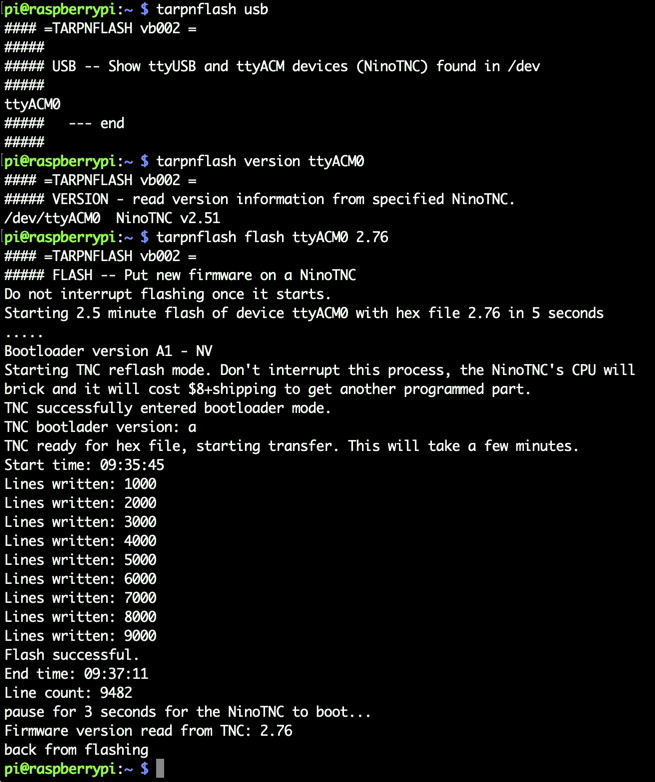TARPNFLASH Bootloader
page modified October 13, 2020
I wrote an installer and management script suite for the Raspberry PI to operate the
python bootloader for the NinoTNC.
The suite provides for easy management of the available hex files to be pushed to the NinoTNC, as well as identification of the NinoTNCs in the Linux device table.
An uninstaller "clean" function is also provided.
The installer puts a file in /usr/local/sbin and also creates a subdirectory in /home/pi called tarpnflash
The installer uses the sudo command only to move the tarpnflash script to /usr/local/sbin
The installer and apps do not reboot the PI.
The installer and apps doesn’t install any services or modify any system files.
The apps depend on the standard Python and Python libraries which come with the full-desktop-install version of Raspbian Buster. I don’t know if these programs and libraries are included in the minimum install version of Raspbian.
The apps and commands are all run from a Terminal window, or Putty session. You can run the Raspberry Pi’s terminal from a VNC session.
There are several hex files supplied and more are to come. The details about each version are in the N9600A History page under https://tarpn.net.d
After installing the program, the update utility will download the latest NinoTNC hex files, leaving your existing legacy copies intact.
As of this writing, the latest released/stable code is 2.51.
You should be able to copy and paste these 4 lines into a terminal window and the suite should fully install.
wget https://tarpn.net/zflash2020oct/tarpnflashinstaller.sh
chmod +x tarpnflashinstaller.sh
./tarpnflashinstaller.sh
ls
After the installer finishes, tell Linux to run
tarpnflash
That will give you a list of commands and some info about parameters.
If your NinoTNC is presently in use by an application, you'll have to quit that application before flashing.
If any of the features are poorly described, or have insufficient error responses (to bad behavior), or get errors when it should be working, please send to this email reflector to this topic.

Thanks to all who have contributed and tested, and those who will come forward in the future.
The TARPN project would welcome more contributors, builders.
TARPN’s main project and ‘killer app’ is an architecture for ham radio to produce a several-dozen-capable round-table chat device which is distributed throughout all of the participating stations. We use a slightly modernized packet-radio system, mostly written by G8BPQ, and implemented on an inexpensive but powerful Raspberry PI computer, across inexpensive surplus 2-way radios to make a VHF/UHF packet radio system, entirely over ham radio. But that’s not what you’ll see. What you see is a lively, no, ROWDY, text chat, sort of like IRC Internet Relay Chat, but running from our own houses. Everybody is a server as the system is fully distributed. Even at 1200 baud it can support dozens of active stations. With 9600 it has legs to grow.
We swear never to use the system from over commercial networks (Internet) or to link the stations over commercial networks.
See
TARPN-HOME New Year's Eve chat Dec31-2019 to Jan01-2020 [youtube]
Scrub through the movie to see the active parts. This is from 10months ago. Our NCPACKET network is bigger now.
Thanks to NC4FG for the fabulous work on the UI.
The UI runs as a Web server on the Raspberry PI and we access it from devices and computers on our local household networks.
We swear to never use it over commercial networks (Internet). All our stations are connected via ham radio.
No Internet required. No Internet desired. No Internet tolerated (except for installation and updates).
3 NinoTNCs pounding away at 9600 baud - May 2020 - NCPACKET is a TARPN [youtube]
